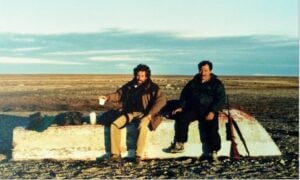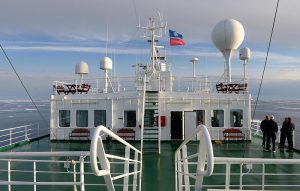
History
2014 Victoria Strait Expedition
This year's search is about much more than underwater archaeology. The Victoria Strait Expedition will contribute to northern science and communities.
- 1205 words
- 5 minutes
This article is over 5 years old and may contain outdated information.
History

“I am delighted to confirm that we have identified which ship from the Franklin expedition has been found. It is in fact, the HMS Erebus,” revealed Prime Minister Stephen Harper during Question Period in Parliament today, Oct. 1, 2014.
Harper was responding to a question posed by Ryan Leef, Conservative Member of Parliament for the Yukon, who had inquired about an update on the discovery of one of Sir John Franklin’s ships from the ill-fated 1845 British Arctic expedition.
The announcement was greeted by applause from the governing Conservative members of the House of Commons. Others outside the government were quick to react.
“Erebus was one of the great exploration ships of its era, of any era,” says John Geiger, CEO of The Royal Canadian Geographical Society. “To find it in such an incredible state of preservation represents a great moment for Canada, for Britain, and for those throughout the world with an interest in geography and exploration.” The Prime Minister announced confirmation of the find on Sept. 9, 2014.
Geiger, a member of the 2014 Victoria Strait Expedition, praised Parks Canada, whose underwater archeologists made the identification, saying the agency has legal responsibility for protecting, documenting and conserving the wreck.
“Franklin was based aboard Erebus, that ship is where he lived and likely where he died. It was at the very centre of this great historical mystery. The stunning condition of the ship and the artifacts represent a global treasure,” continues Geiger, who co-wrote Frozen In Time: The Fate of the Franklin Expedition with Owen Beattie, a now retired professor of anthropology at the University of Alberta.
The 32-metre-long (105 foot) Erebus, which was captained by Sir John Franklin himself during the 1845 Arctic expedition, was constructed in Pembroke, Wales, and launched on June 7, 1826. It served in the Mediterranean and Antarctic before its final Arctic mission.
Originally designed as a Royal Navy bomb ship, the Erebus was converted into a polar exploration vessel in the 1830s. Before departing for the Canadian Arctic, however, Erebus underwent further, more extensive modifications. The ship was strengthened so it could handle the grinding force of Arctic pack ice. A second layer of planking was added to the hull, the interior wall of which was reinforced with 25-centimetre-thick beams. It was also additionally reinforced with a diagonal iron brace on the interior of its hull. Iron sheeting covered the exterior of the hull, extending back about six metres from the bow. The ship also featured diagonally cross-planked decks, a design that helped absorb and distribute the force of impacts over a wider area. When Ryan Harris, a senior marine archeologist with Parks Canada, saw the remains of this distinctive diagonal planking on a side-scan sonar image during the 2014 search, he knew he and his team had found one of Franklin’s ships. The only question then was which one? Now we know.
Are you passionate about Canadian geography?
You can support Canadian Geographic in 3 ways:

History
This year's search is about much more than underwater archaeology. The Victoria Strait Expedition will contribute to northern science and communities.

History
Arctic historian Ken McGoogan takes an in-depth, contemporary perspective on the legacy of Sir John Franklin, offering a new explanation of the famous Northern mystery

People & Culture
On April 12, Franklin enthusiasts had a rare opportunity to come together in the same room as The Royal Canadian Geographical Society presented their 2016 Can Geo Talks

History
First official day of the 2014 search for Sir John Franklin’s lost ships